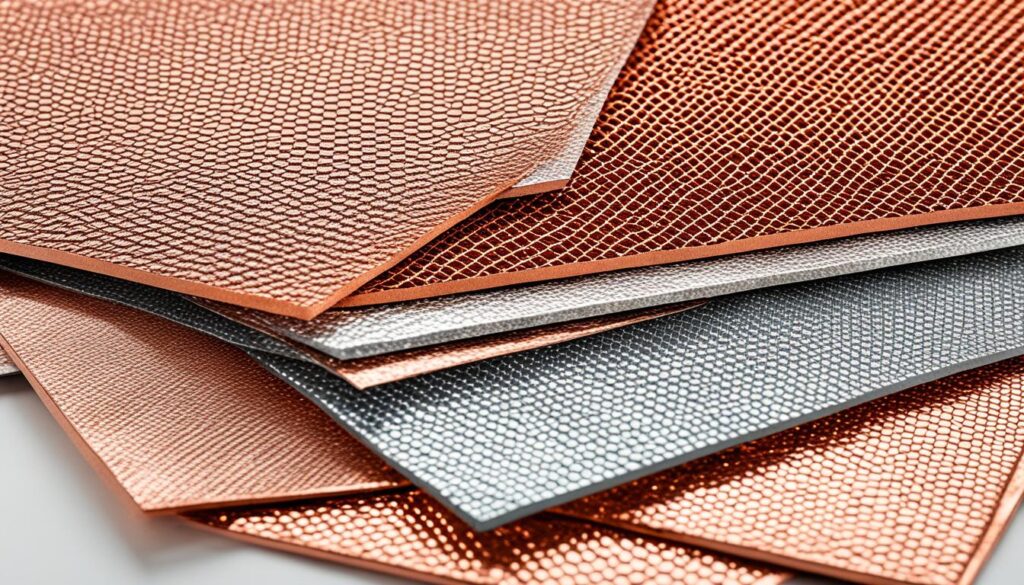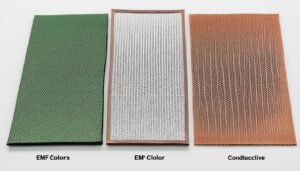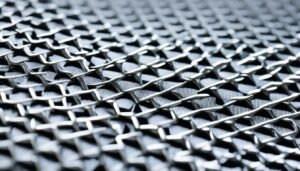Disclosure: This Post Contains Affiliate Links; We earn a commission on purchases.
EMF Shielding Materials Overview: Discover the key to electromagnetic frequency protection with effective EMF shielding solutions.
Electromagnetic radiation is all around us, emanating from various sources such as cell phones, Wi-Fi routers, and power lines. While these technologies have revolutionized our lives, they also expose us to potential health risks associated with prolonged EMF exposure.
That’s where EMF shielding materials come into play. These materials act as a protective barrier, blocking or attenuating electromagnetic waves and creating a safe environment for electronic devices. With the increasing prevalence of EMF exposure in our modern world, understanding different types of shielding materials and their effectiveness is vital.
Key Takeaways:
- EMF shielding materials provide an effective solution for protecting against electromagnetic radiation.
- They block or attenuate electromagnetic waves, creating an interference-free environment for electronic devices.
- Conductive materials, such as copper and aluminum, are commonly used for their high electrical conductivity.
- Shielding effectiveness depends on factors such as conductivity, thickness, and design of the shielding structure.
- Choosing the right type of shielding material is essential for specific application requirements.
Understanding Electromagnetic Fields and Their Impact
Electromagnetic fields (EMFs) are part of our everyday environment, originating from both natural and human-made sources. These fields consist of electric and magnetic components that propagate as waves, carrying energy and information. The characteristics of these waves, including their frequency, wavelength, and amplitude, play a significant role in determining how EMFs interact with their surroundings.
EMFs have various applications in our modern world, powering technologies such as wireless communication, electricity generation, and medical imaging. However, their presence can also lead to unwanted interference and disruptions in sensitive electronic systems. To combat this, the use of EMF radiation blocking materials becomes essential.
“The electromagnetic waves that make up EMFs have different frequency ranges, measured in Hertz (Hz). The frequency determines how many wave cycles occur in a second.”
The Fundamentals of Electromagnetic Fields
EMFs are characterized by their frequency, which indicates the number of wave cycles occurring per second. The higher the frequency, the more wave cycles occur, resulting in a shorter wavelength. Conversely, lower frequencies have fewer wave cycles and longer wavelengths. For example, radio waves have lower frequencies and longer wavelengths compared to visible light waves.
The amplitude of an electromagnetic wave refers to the height or intensity of the wave’s oscillation. It affects the energy carried by the wave, with higher amplitudes reflecting stronger intensity. The amplitude can influence how EMFs interact with objects and their ability to induce an electric current.
Shielding materials, such as conductive metals and specialized coatings, are designed to block or attenuate EMFs by reflecting, absorbing, or dissipating the waves. These materials act as barriers, preventing EMFs from penetrating sensitive areas or interfering with other electronic devices nearby. By utilizing EMF radiation blocking materials, we can safeguard our electronic components and minimize the risk of interference and disruptions.
The Impact of Electromagnetic Fields
EMFs can have both positive and negative effects on our surroundings. On one hand, they enable wireless communication, power our devices, and facilitate medical imaging techniques that save lives. On the other hand, excessive exposure to EMFs can lead to interference, compromising the functionality of electronic devices and potentially posing health risks.
Electromagnetic interference (EMI) occurs when the electromagnetic fields from one device interfere with the operation of another nearby device. This interference can disrupt signals, degrade performance, and even cause malfunctions. Shielding materials serve as a barrier to prevent unwanted EMI, ensuring the reliable operation of electronic systems.
Certain industries, such as healthcare and aerospace, require strict adherence to regulatory standards when it comes to EMF exposure. Shielding materials are essential for compliance with these standards, protecting both patients and critical systems from excessive EMFs that could compromise safety or performance.
The Principles of Electromagnetic Shielding
Electromagnetic shielding is a vital technique used to protect against the harmful effects of electromagnetic waves. By employing materials that reflect, absorb, or dissipate electromagnetic waves, shielding acts as a barrier, redirecting the path of electromagnetic fields. This prevents their penetration into sensitive areas or emission from specific sources.
When it comes to selecting the best EMF shielding products, conductive materials are often the top choice. Conductive metals like copper and aluminum possess high electrical conductivity, making them effective options for shielding applications. These materials provide an efficient pathway for the dissipation of electromagnetic waves.
The effectiveness of electromagnetic shielding is influenced by various factors, including the conductivity, thickness, and design of the shielding structure. The shielding effectiveness quantifies a material’s ability to block or reduce electromagnetic waves. It is crucial to consider these factors and select the appropriate materials to ensure optimal shielding effectiveness.
The Importance of Electromagnetic Shielding
Electromagnetic shielding plays a critical role in various industries and applications, providing protection against electromagnetic interference (EMI) and ensuring the reliable operation of electronic devices. Shielding materials are essential for maintaining signal integrity, preserving the quality and accuracy of data transmission. Compliance with regulatory standards is also a vital consideration in industries such as aerospace, healthcare, and telecommunications.
Proper electromagnetic shielding helps to ensure safety and prevent potential health risks associated with prolonged exposure to electromagnetic fields (EMF). By utilizing the right shielding materials, industries and individuals can create a safe and interference-free environment for electronic systems.
The Impact of Electromagnetic Interference (EMI)
Electromagnetic interference (EMI) refers to the disturbance caused by electromagnetic radiation emitted from various sources. This interference can adversely affect the performance of electronic devices, leading to signal degradation, data corruption, or even complete system failure. By incorporating effective shielding methods, such as EMF shielding fabric options, organizations can minimize the impact of EMI and ensure consistent operation of their electronic systems.
Maintaining Signal Integrity
Achieving and maintaining signal integrity is essential for the proper functioning of electronic systems. EMF shielding materials help to prevent electromagnetic interference, ensuring that signals remain free from disruptions and noise. This is particularly important in applications where accurate data transmission is critical, such as telecommunications, industrial automation, and medical equipment.
By using high-quality shielding materials that meet regulatory standards, organizations can maintain signal integrity, resulting in reliable and efficient communication between electronic devices.
Compliance with Regulatory Standards
In various industries, compliance with regulatory standards is not just a requirement but also a necessity. Organizations must ensure that their electronic systems meet the relevant electromagnetic compatibility (EMC) standards to prevent interference and potential safety hazards. Shielding materials that adhere to the prescribed regulatory standards not only offer optimum performance but also guarantee conformity and reliability.
Ensuring Safety and Health Protection
Proper electromagnetic shielding also plays a crucial role in ensuring safety and protecting individuals from potential health risks associated with prolonged EMF exposure. By using efficient shielding materials, organizations can minimize the levels of electromagnetic radiation emitted from electronic devices, reducing the potential impact on human health.
Shielding materials that meet the required specifications for safety and health protection provide peace of mind, both for individuals using electronic devices and for organizations concerned about the well-being of their employees or customers.
Types of EMF Shielding Materials
When it comes to protecting against electromagnetic radiation, there are various types of EMF shielding materials available, each with its own unique properties and benefits. Choosing the right material is crucial to ensure effective shielding and minimize the risk of interference. Let’s take a closer look at some of the commonly used types of EMF shielding materials:
Conductive Metals
Conductive metals, such as copper and aluminum, are widely used in EMF shielding due to their high electrical conductivity. These metals are excellent at reflecting and absorbing electromagnetic waves, making them an ideal choice for shielding applications. Conductive metals can be used in various forms, including sheets, foils, meshes, and tapes, and they can provide effective shielding across a wide range of frequencies.
Conductive Coatings
Conductive coatings, such as paints and platings, offer versatility in shielding applications. These coatings contain conductive particles or compounds that create a conductive layer on the surface to block and redirect electromagnetic waves. Conductive coatings can be applied to different materials, including plastic, glass, and non-conductive metals, making them suitable for a variety of surfaces. They are commonly used in electronic enclosures, circuit boards, and other components that require effective EMF shielding.
Magnetic Shielding Materials
For blocking low-frequency magnetic fields, magnetic shielding materials are the go-to solution. These materials, such as mu-metal or ferrites, have high magnetic permeability, allowing them to redirect or absorb magnetic fields. Magnetic shielding materials are particularly effective in shielding against static or low-frequency magnetic fields produced by power lines, transformers, and other equipment. They are commonly used in applications such as MRI rooms, electrical installations, and sensitive electronic devices.
When selecting an EMF shielding material, it’s essential to consider the specific requirements of the application, including the frequency range, level of shielding effectiveness needed, and the compatibility with other materials or equipment. Consulting a shielding materials guide or seeking professional advice can help ensure the right choice for your EMF protection needs.

Applications of EMF Shielding
The effectiveness of EMF shielding extends across various industries that require protection against electromagnetic interference. Let’s explore some of the key sectors where EMF shielding plays a critical role:
1. Electronics and Telecommunications
In the electronics and telecommunications industry, EMF shielding is essential to prevent interference and ensure optimal performance. Shielding materials are commonly used in circuit boards, cables, and enclosures to protect electronic devices from electromagnetic radiation. Effective shielding solutions enable seamless communication and reliable operation of electronic systems.
2. Medical and Healthcare
In the field of medical and healthcare, sensitive medical equipment must be shielded from external electromagnetic interference. EMF shielding materials are used to safeguard the integrity of medical devices, ensuring their accurate functionality. This protection is crucial in environments such as hospitals and clinics where precise measurements and diagnostic tools are deployed.
3. Aerospace and Defense
In the aerospace and defense sectors, shielding plays a vital role in the reliable operation of avionics, navigation systems, and communication devices. The high level of electromagnetic noise in these environments necessitates the use of effective shielding materials. By utilizing EMF shielding, aerospace and defense industries can maintain signal integrity, enhance communication systems, and ensure the safety of critical equipment.
4. Automotive and Transportation
Automotive and transportation industries heavily rely on electronic systems for various functionalities, such as electrical wiring, infotainment systems, and control modules. EMF shielding is crucial to prevent interference that could disrupt these systems. Shielding materials help maintain signal integrity, reduce electromagnetic noise, and ensure the reliable operation of vehicles.
5. Industrial and Power Systems
In industrial settings, electromagnetic interference can have severe consequences, leading to equipment malfunction or power supply issues. EMF shielding in industrial and power systems helps protect control systems, electrical equipment, and sensitive instrumentation from external electromagnetic influences. Shielding solutions enable reliable operations and minimize the risk of electromagnetic disturbances.

By deploying appropriate EMF shielding solutions, these industries ensure the protection of electronic systems, enhance performance, and mitigate the risks associated with electromagnetic interference.
Conclusion
EMF shielding materials are a crucial component in protecting against the harmful effects of electromagnetic radiation. They play a vital role in ensuring the reliable operation of electronic devices by providing effective protection against interference. As the prevalence of EMF exposure continues to increase in our modern world, it is essential to understand the principles and applications of electromagnetic shielding.
By utilizing the right type of shielding material, industries and individuals can create a safe and interference-free environment for electronic systems. Whether it’s in the electronics and telecommunications industry, medical and healthcare field, aerospace and defense sectors, automotive and transportation industry, or industrial and power systems, EMF shielding solutions are essential for maintaining signal integrity and compliance with regulatory standards.
Consideration of the various types of EMF shielding materials, such as conductive metals, conductive coatings, and magnetic shielding materials, is important in selecting the optimal solution that meets the specific requirements of each application. With the right choice of shielding materials, industries can ensure the protection of their sensitive electronic devices and prevent potential health risks associated with prolonged EMF exposure.
Source Links
- https://www.compeng.com.au/electromagnetic-shielding-understanding-basics/
- https://www.ncbi.nlm.nih.gov/pmc/articles/PMC10054763/
- https://www.sciencedaily.com/releases/2020/07/200702113703.htm

Subscribe to Our Newsletter










